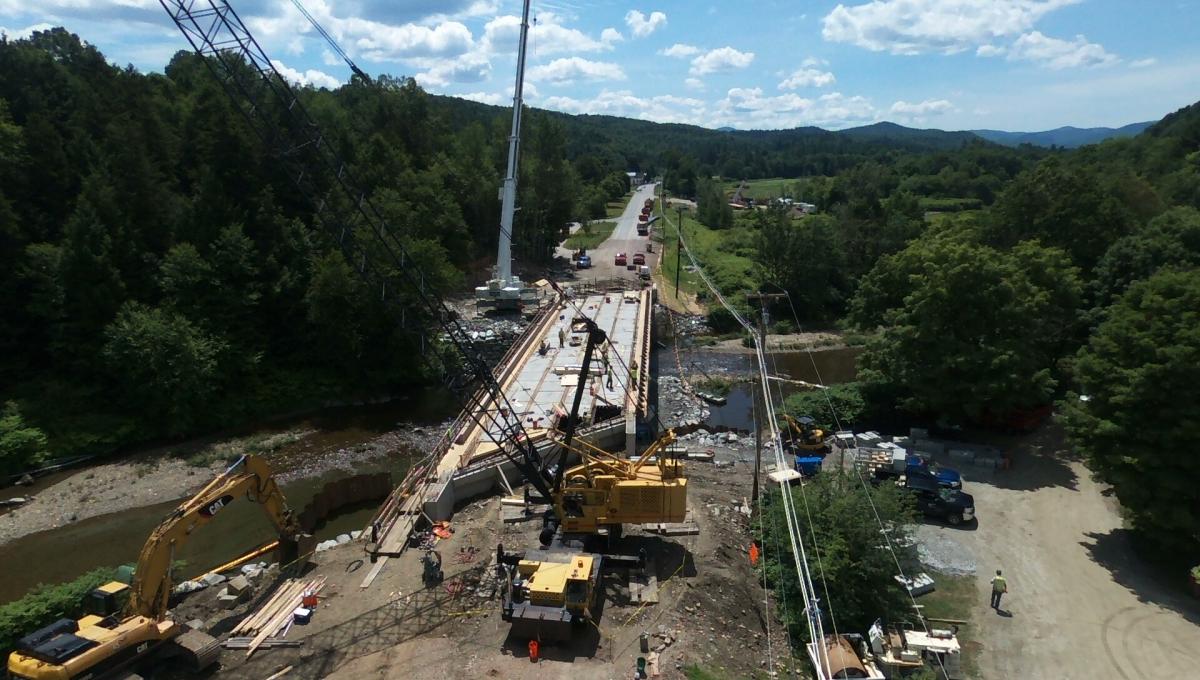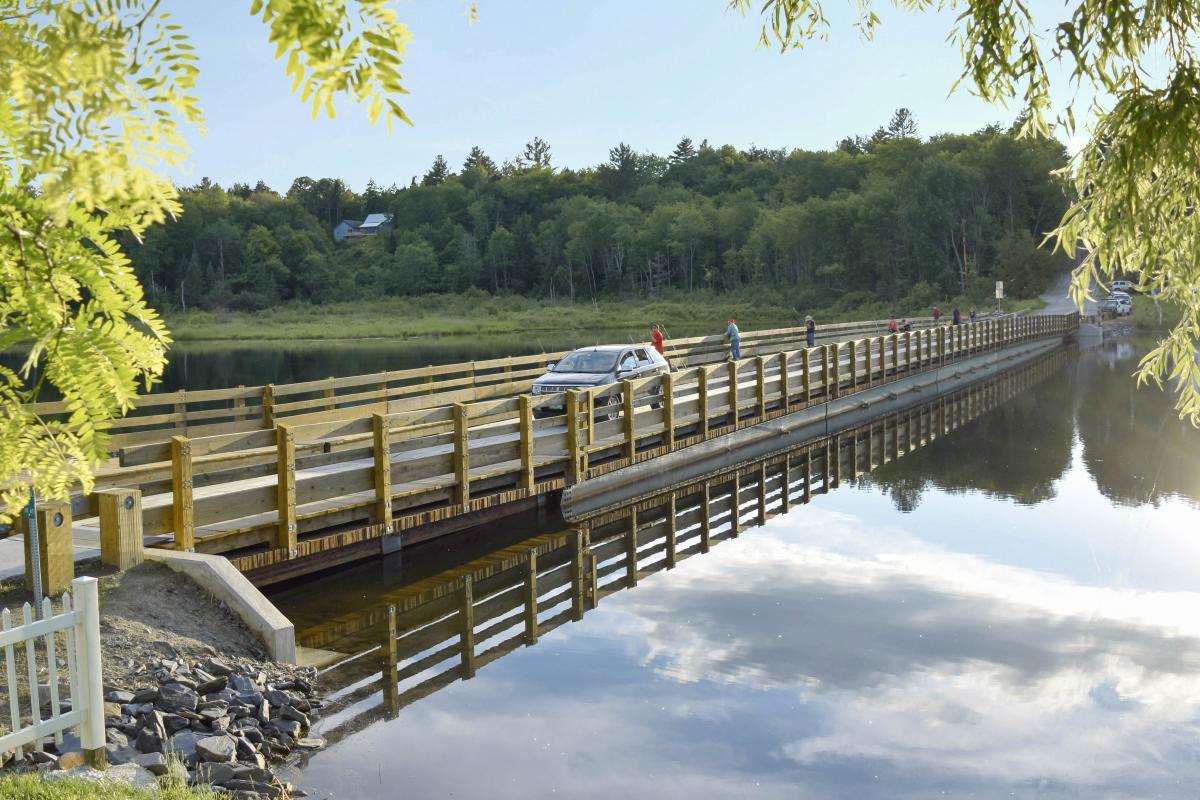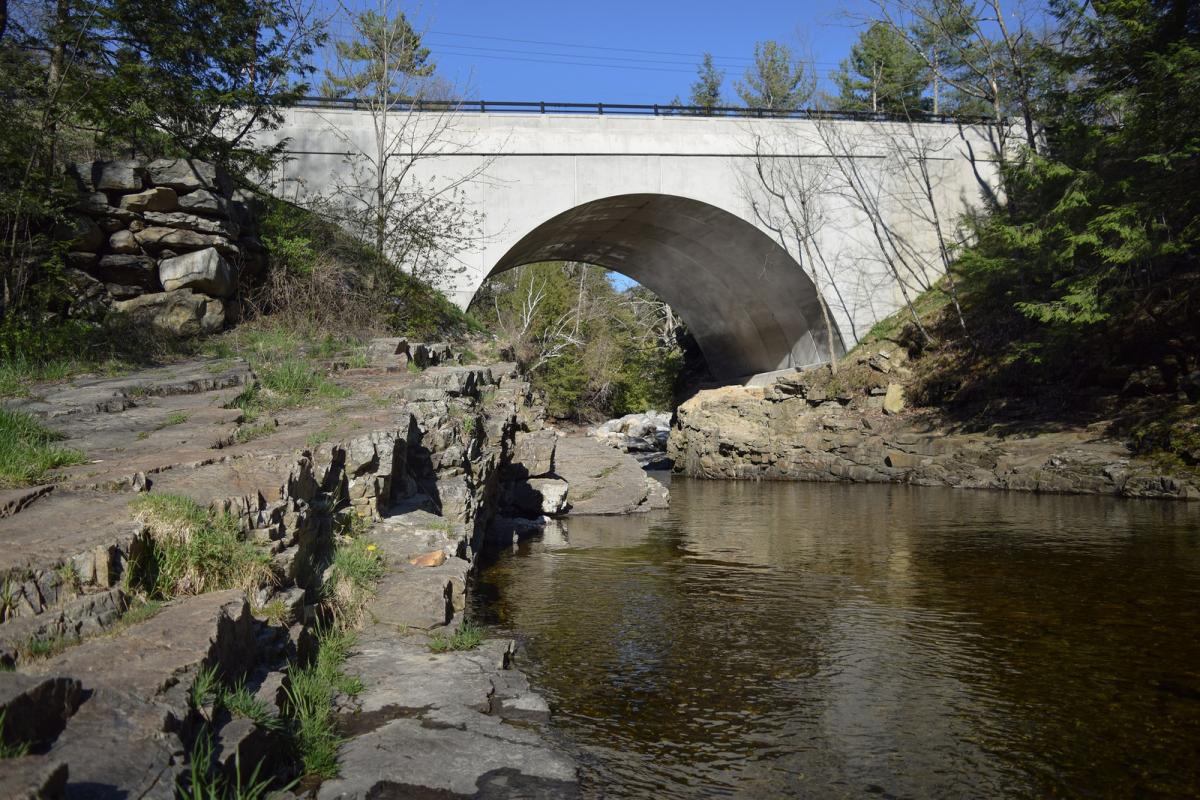Georgia BF 023-1(7)
The Georgia Bridge 1 project will replace the existing single span bridge with a new bridge during a 45-day bridge closure. The bridge is located on a narrow causeway constructed over Arrowhead Mountain Lake. The Georgia project is one of two projects currently in development that will utilize Partial Depth Deck Panels. This innovation combines prestressed ABC techniques with traditional cast-in-place methods. The bridge is scheduled to be constructed during the summer of 2020. Accelerated bridge construction was chosen for this project based on a need to reduce impacts to adjacent properties and cultural and environmental resources and ultimately reduce the project development duration. The bridge was reduced down to one-way alternating traffic as a result of a truck collision that occurred in September of 2018 that damaged the bridge railing. Currently, there is F-Shape concrete barrier on the structure as an interim solution.
Hartland IM 091-1(68)
This bridge project in Hartland will be the first use of Geosynthetic Reinforced Slope - Integrated Bridge System (GRS-IBS) for bridges in Vermont. The project will replace the entire 6-span, 360-foot long bridge over Interstate 91 with two short, single-span bridges using GRS-IBS structures in the median for abutments. Preliminary cost estimates indicate that the GRS-IBS technology will reduce the project cost from the originally considered superstructure replacement while improving the life of the bridge. Due to their scour susceptibility, GRS-IBS systems are generally overlooked for use as abutments. The Hartland bridge project provided a great opportunity to use this innovation in a dry setting.
Colchester IM 089-3(69)
This Accelerated Bridge Construction project included the replacement of four bridge decks on Vermont I-89 between exits 16 and 17 in the town of Colchester. The 7 ½” concrete decks on Bridges 76N and 76S over Bay Road and Bridges 77N and 77S over Mallet’s Creek were replaced with 8 ½” precast Deck Panels. TL-5 Concrete barrier and new expansion joints were also be installed as part of the project.
Because of high traffic volumes during commuting hours, restrictions are in place for lane reductions. Two-way traffic needed to be maintained between the hours of 6:00 am and 9:00 am for the southbound traffic and 3:00 pm and 6:00 pm for the northbound traffic during the week. The contractor had access to the bridges during non-peak hours during a closure of one weekend for each bridge to complete the work. Crossovers were used to maintain traffic during construction.
Construction of the new bridge decks began in April of 2019 and was completed by December of 2019.
Waitsfield BRF 013-4(39)
The VT100 bridge project in Waitsfield was the first use of Ultra-High Performance Concrete (UHPC) in Vermont. The 180-foot long bridge was replaced in the summer of 2016 during a 35-day bridge closure with traffic detoured onto locally owned roads. During the closure, the old bridge was demolished, and new superstructure elements were lifted into place using heavy lifting equipment. The use of UHPC for the joint between the elements allowed for great time savings and resulted in a closure pour that was 10 times stronger than traditional concrete - now that’s strong! The pour was performed in 2 days and used wheelbarrows to move the concrete from the mixer to the pour location. Cylinders were made on site and then brought to Advance Testing for compressive strength tests. After 6 days the average compressive strength of the concrete was 21,173 PSI. The goal of UHPC was to get a more durable joint and hopefully save some time. Installation of the concrete was overall a success. Strength of final product met the anticipated results. Final costs were higher than anticipated - if a nonproprietary product becomes available it could broaden its use and make it a more cost-efficient product. Learn more about this innovative material on our Innovation page.

Hartford IM 089-2(79)
Vermont's first bridge replacement project using Slide-In Bridge Construction took place over the summer of 2015. This innovative means of bridge replacement allowed for great time savings and resulted in only minor impacts to this busy section of interstate. The two bridges located on I91 in the town of Hartford were completely removed and replaced in just two weekends. New bridges were constructed on temporary supports adjacent to the existing structures while crews worked on foundations for the new bridges underneath the existing bridges. Check out the aerial photo and the timelapse video below and see just how easy it was to accomplish this innovative engineering feat! Or, learn more about this innovative project on our Innovation page.
Slide in Bridge Construction video
Tapping into Modern Technology to Replace a Historic Structure, Brookfield
The Brookfield Floating Bridge, originally constructed in 1820, is only one of three floating bridges in the United States. Best known for its floating timber bridge deck, flanking sidewalks and bridge rail, the structure has been replaced 7 times since it was originally constructed as the floatation systems became waterlogged leading to the eventual sinking and failure of the bridge structure. The new floating bridge, opened in May of 2015, utilizes a modern technology known as fiber reinforced polymer (FRP) for the floatation system. FRP is extremely durable, corrosion resistant, and resistant to stresses and strains produced by ice loading and other lateral forces such as impacts from boats. With its modular pontoon construction comprised of five FRP rafts, portions of the bridge can be disassembled and repaired, if necessary. The new Brookfield Floating Bridge is expected to provide a service life of 100 years serving current and future generations of Vermonters and tourists alike. For more information: https://www.youtube.com/watch?v=aIaoHVqp1dk.

A Regionalized Approach to ABC, Rochester/Middlebury/Warren
Five bridges were replaced in record time using accelerated bridge construction methods and short term road closures including Bridge 13 on VT 125 in East Middlebury, Bridges 13, 15, and 16 on VT 73 in Rochester and Bridge 166 on VT 100 in Warren. All five bridge replacement projects required significant coordination of the bridge closure periods and alternating detour routes. For example, when VT 125 was closed, traffic was detoured onto VT 73. To ensure the traveling public was well informed, various public outreach strategies were utilized including project factsheets, preclosure public information meetings, and a dedicated website and weekly email updates for real time information. A public survey was distributed after construction to learn more about the public’s perspective on using the ABC approach to replacing bridge structures, the techniques used to communicate with the public, and satisfaction with the new bridge structures. Responses from a customer survey following the completion of the projects indicate that 83 percent of the 41 respondents were very satisfied with accelerated bridge construction and 74 percent were very satisfied with the information that they received about the projects during construction.

